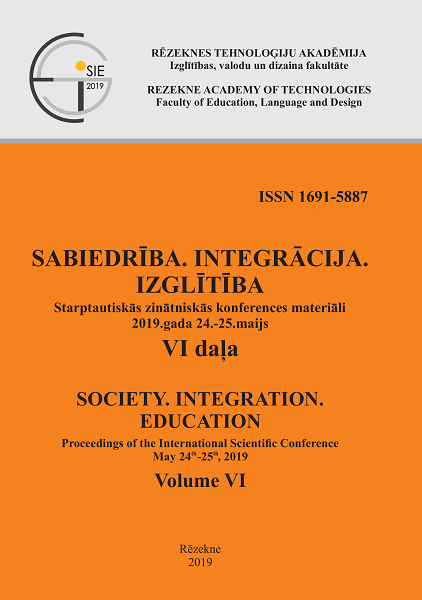SOCIAL FINANCE TAXONOMY IN TRANSITION TOWARDS A MORE SUSTAINABLE ECONOMY
DOI:
https://doi.org/10.17770/sie2019vol6.3835Keywords:
social impact investing, social finance, taxonomyAbstract
The successful development of a sustainable economy and society in together with the Sustainable Development Goals (SDG-2030) requires comprehensive and coordinated efforts of governments, businesses and civil society in order to establish unified and clear rules and regulations for economic activity. In order to reach this goal the European Union begun the development of EU sustainability taxonomy, which is to ensure an equal understanding of the content of activities of enterprises, projects and investments that meet sustainability criteria. So as to realize the potential of the market for social investments and loans, unification of approaches for understanding the main concepts of the social financing process is necessary.
The purpose of the study is to develop proposals for the classification of subjects and objects of the subsystem of social finance consistent with sustainability taxonomy. The research applies methods of induction and deduction, scientific abstraction of theoretical generalization and comparative analysis while studying definitions, best practices of social investment and for developing the classification of social impact investments and social enterprises. The article provides coherent analysis of the formation of social entrepreneurship and finance in Ukraine. Based on the results of the study, the most relevant classification features of social enterprises and investments were developed and recommendations were made for integrating social finance taxonomy into sustainability taxonomy. The results of the research are of both theoretical and practical value.
References
Big Society Capital (2016). Big Society Capital: Social Impact Tests, Retrieved from https://goo.gl/Kbh5GK
Bridges Fund Management (2015). The Bridges spectrum of capital: How we define the sustainable and impact investment market. Retrieved from http://www.bridgesfundmanagement.com/wp-content/uploads/2017/08/Bridges-Spectrum-of-Capital-print.pdf
City of London Corporation (2014). New Specialist Sources of Capital for the Social Investment Market. Research Report City of London Corporation. Retrieved from https://goo.gl/WD2kJd
Charity Bank (2017) Measuring social impact: our approach. A brief guide to how and why we measure Impact. Retrieved from https://charitybank.org/uploads/files/Charity-Bank-Measuring-our-social-impact.pdf
Corestone Group & GFK Ukraine (2017). Research of charitable organizations and participation of the population in charity and volunteer projects. Research on the order of the Zagory family. Retrieved from http://zagoriy.foundation/Charity_report_2017_Zagoriy_Foundation.pdf
CSSP (2014). My Impact - Fundamentals of Modern Philanthropy. New Perspectives for Foundations. Center for Social and Sustainable Products AG. Retrieved from https://goo.gl/BkKeD2
Daggers, J., & Nicholls, A. (2016). The Landscape of Social Impact Investment Research: Trends and Opportunities. Retrieved from http://eureka.sbs.ox.ac.uk/7019/1/Landscape-of-social-impact-investment-research.pdf
ECCOS International (2017). Impact Investing from Margin to the Mainstream. Retrieved from http://bit.ly/Impact_investing_From_Margin_to_the_Mainstream
European Commission (2018). Action Plan: Financing Sustainable Growth. Retrieved from https://eur-lex.europa.eu/legal-content/EN/TXT/?uri=CELEX:52018DC0097
Eurosif (2017). SDGs for SRI investors. Retrieved from http://www.eurosif.org/wp-content/uploads/2017/04/SDG_Eurosif-1.pdf
Evenett, R., & Richter, K.H. (2011). Making good in social impact investment: Opportunities in an emerging asset class. Retrieved from http://www.engagedx.com/downloads/Making_Good_In_Social_Impact_Investment.pdf
GIIN (2017). Annual Impact Investor Survey 2017. Retrieved from https://thegiin.org/assets/GIIN_AnnualImpactInvestorSurvey_2017_Web_Final.pdf
GIIN (2018). Annual Impact Investor Survey 2018. Retrieved from https://thegiin.org/assets/2018_GIIN_Annual_Impact_Investor_Survey_webfile.pdf
Grebennikov E. (2017). Dilems of "profit vs. public good" no longer exist. Retrieved from https://www.epravda.com.ua/columns/2017/08/14/627988/
GSIA (2016). Global Sustainable Investment Review 2016. Retrieved from https://www.ussif.org/files/Publications/GSIA_Review2016.pdf
Gusak N. (2016). Best Experience and Contemporary Trends in the Development of Social Entrepreneurship: Ukraine (Study Results). Retrieved from https://drive.google.com/file/d/0B6tjJF2tZgGHeVdVTTM4MWx6N1E/view
Institute for social banking (2018), What is social banking, Retrieved from http://www.social-banking.org/the-institute/what-is-social-banking/
Nicholls A., Paton R., Emerson, J. (2015). Social Finance. Oxford University Press.
OECD (2015), Social Impact investment: Building the Evidence Base. Retrieved from http://www.oecd.org/publications/social-impact-investment-9789264233430-en.htm
OXFAM (2017). Impact investing: Who are we serving? A case of mismatch between supply and demand. Oxfam discussion paper. Retrieved from https://www.oxfamamerica.org/static/media/files/dp-impact-investing-030417-en.pdf
PRI (2018). Impact investing market map 2018. Retrieved from https://www.unpri.org/download?ac=5426
Relano, F. (2015). Disambiguating the concept of social banking, Journal of Finance and Risk Perspectives. Special Issue of Social and Sustainable Finance. 4 (3). 48-62.
UNDP (2016). Impact Investment. Retrieved from https://goo.gl/35bhcF
Wilson, Karen E. (2016). Investing for social impact in developing countries, in OECD, Development Co-operation Report 2016: The Sustainable Development Goals as Business Opportunities, OECD Publishing, Paris, Retrieved from https://doi.org/10.1787/dcr-2016-11-en
WNISEF (2017). Support for sustainable changes. Annual report. Western NIS Enterprise Fund Publishing. Retrieved from http://wnisef.org/uk/impact-investing






